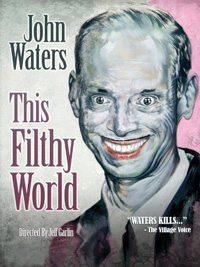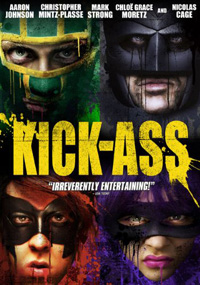The Proposition

The Proposition is story of a lawman (Winstone) down under that gives a career killer (Pearce) the chance to save his little brother from the gallows if he can find his older brother (Huston) and execute him.
Written by musician Nick Cave of Bad Seeds fame, the script is brutal, authentic and filled with fantastic period dialogue. Every character is brilliantly realized - no true heroes or absolute villains - just multi-dimensional people wrapped up in a tragic place. Cave and Warren Ellis provide the film’s score with is a glorious mixture between primal sounds of the native culture, mixed with contemporary instruments.
Continue ReadingOnce Upon A Time In The West

Sergio Leone's giant mega-Spaghetti Western is the ultimate Spaghetti Western. It may be the greatest Western of all time, period (it's at least up there with Shane and The Wild Bunch) and it’s one of my favorite films of all time. Like a novel, we are introduced very carefully to four separate characters, their motives and links to each other slowly come together. Like an opera, Ennio Morricone's masterful score gives each character their own theme. Once Upon A Time In The West is such a unique and fascinating film, it's no wonder that its influence can be seen in so many films after it, including the works of directors Quentin Tarantino, John Woo, Clint Eastwood, and Robert Rodriguez.
The Spaghetti Western is a term which refers to a genre of Westerns generally starting in the 1960s which were produced by Italians (but often shot in Spain). They usually had another Euro co-financier (usually Spain) and they would use an international cast (usually Italians and Spaniards and maybe an American) to sell the film in different countries. The '70s would also see the rise of sub-genres such as Spaghetti Gangster and Spaghetti Zombie flicks. A number of Spaghetti Western directors had an impact like Enzo Barboni (They Call Me Trinity), Sergio Sollima (The Big Gundown), Gianfranco Parolini (the Sabata trilogy), and Sergio Corbucci (Django). But the big dog, the Orson Welles of the genre, was Sergio Leone. He hit it big with his "Dollars trilogy" (Fistful Of Dollars, For A Few Dollars More, and The Good, The Bad And The Ugly). Beside Leone himself the trilogy also made international stars out of the score's revolutionary composer, Morricone, and its star, Clint Eastwood, then only known as a hack American TV actor.
Continue ReadingThe Big Trail

On the eve of the Depression, studio and theater owner William Fox decided that something new was needed in film exhibition. So he created Fox Grandeur – the first 70mm widescreen projection system. The process used to sometimes mind-boggling effect in The Big Trail, Raoul Walsh’s early sound Western.
The feature supplied the first starring role for the unbelievably young John Wayne, who plays Breck Coleman, a scout who signs on to lead a wagon train of settlers from Missouri to the Pacific Northwest. Along the trail, he romances a comely pilgrim (Marguerite Churchill), is menaced by a trio of deadly baddies (Tyrone Power, Sr., Charles Stevens, and Ian Keith), and faces perils ranging from a tribe of hostile Indians to the raging elements.
Continue ReadingJeremiah Johnson

"The mountain's got its own ways." --Jeremiah Johnson Among those who are big fans of the Western genre, I find myself having to defend this delightful movie. Aside from the repetition in the soundtrack, I couldn't come up with a single complaint. It is known and kept in high regard for its breathtaking cinematography (Duke Callaghan [Conan the Barbarian]) and for the fact that it was shot entirely on the mountains of Utah. We find Jeremiah Johnson (Robert Redford), a man fresh from a war, and set on avoiding the coming Mexican War, who also wants to make a clean break from society. He decides to learn how to become a trapper, hunting various types of game in order to survive and trading furs with local tribes. His quest was both to define himself and to break free of social constraints, and yet he discovers that every land has a law. These rules are breakable, but not excusable merely by ignorance. Soon he finds out that the mountain and its tribes intend to put him in his place. Their presence is not needed at first. Poor Jeremiah is a terrible shot and can hardly get a fire going in the harsh winter. He stumbles upon an eccentric, old, white man by the name of Bear Claw (Will Geer), the nickname coming from his hobby of hunting and skinning grizzly bears and the necklace of their claws that he wears. He teaches Jeremiah skills that a good trapper needs and warns him about the tribes and their rules until Jeremiah can go off on his own. However, his every move is tracked by two tribes: the friendly Franco-dominated Blackfoot, who speak French and are Christian; and the Crow—a ruthless and well-hidden tribe who've kept a close eye on him since he arrived. Their territory is the land on which he eventually settles. He keeps to himself, communicating with them only in times of trade and thus gaining their respect. Others were not as lucky...
Continue ReadingButch Cassidy and the Sundance Kid

The massive hit from 1969, Butch Cassidy and the Sundance Kid, is often cited as a "Western that people love, who usually don’t like Westerns." But it also often makes "all-time most overrated" lists, especially from folks who do like Westerns. That contradiction may be because the film is completely carried by the charisma of its two superstars, Paul Newman and Robert Redford. Also it's closer in spirit to a light comedy or even the "outlaw reexamination" genre started by Bonnie and Clyde than the landmark Westerns of its era that Sam Peckinpah and Sergio Leone were directing at the same time. Butch Cassidy and the Sundance Kid is an incredibly simple tale, and regardless of its place on the Western checklist it’s perfect entertainment.
The script seems to have very little dialogue and often the same lines are repeated, "You keep thinking, Butch," which is ironic since the script by William Goldman (Marathon Man, All The President’s Men) has been hailed for its perfect three-act structure (pre-film school era Goldman wrote a number of books about screenwriting and the business which also helped elevate his status as a quintessential writer). Act One is an introduction to Butch (Newman) and Sundance (Redford), two charming but frustrated bank robbers who are now hitting trains. Butch is the brains and Sundance the gunman. They also share a woman, schoolteacher Etta Place (the mumbly Katharine Ross of The Graduate), Sundance is her lover, while Butch flirts but is more the big brother. Act Two is one long chase as a hardcore posse follows Butch and Sundance over miles of picturesque Western plains (shot by the legendary cameraman Conrad L. Hall), ending famously with the two jumping off a cliff into a raging river. Act Three has the heroes and Etta traveling to Bolivia where they work as muscle for a paymaster (Strother Martin) and culture clashes impede their bank robbing career, finally ending with a shoot out with the Bolivian army.
Continue ReadingMagic And Bird: A Courtship of Rivals

From Leni Riefenstahl‘s controversial Olympia to Pumping Iron to Hoop Dreams, great sports documentaries often tell us more about society and the times than the actual sport. Ken Burns' epic Baseball is equally important as a history of 20th century America as it is for its bats and balls. In recent years ESPN and HBO have been at the forefront of excellent sports documentaries, ESPN with their outstanding 30 For 30 series and HBO has continually produced great feature length docs, Magic And Bird: A Courtship of Rivals is no exception.
Fascinating as both a study of two athletes, complete opposites who went from mortal enemies to friends, it also establishes how their rivalry helped to transform the NBA and save it from financial disaster. It also sharply touches on hot button issues that the two men represented or found themselves thrust into the middle of, race and race relations and later, tragically, AIDS.
Continue ReadingRichard Pryor Live On The Sunset Strip

It’s a given that Richard Pryor is one of the most influential stand-up comedians ever (along with Lenny Bruce or George Carlin or Mort Sahl or whoever you want to put on a short list). His feature length performance film, Richard Pryor Live On The Sunset Strip, along with Richard Pryor Live in Concert a few years earlier, are still the benchmarks for stand-up comedy films. Sunset Strip may be slightly stronger because of the incredible autobiographical detail and honesty. He might have been a train wreck in real life, but on stage he was completely self-assured - without being cocky - and utterly honest about his own shortcomings, not to mention his takes on sex and race. Besides being hilarious, this film stand as a documentary about the mind of Richard Pryor and the unique way he interprets the world.
Like Bruce and Carlin, Pryor started off a TV-friendly, joke man who evolved when he found himself, got dangerous, got dirty, and embraced the counterculture. On The Sunset Strip is almost like an autobiographical one-man show; he talks about growing up in a brothel, how going to Africa changes him, working for the mob, but, most revealing, his cocaine abuse. In an almost too honest moment he discusses his famous "blowing himself up" incident. At the same time he still hits some great standards like the differences between men and women and black and white people. He also does his down & out character of Mudbone, for what he claims, thankfully, is the last time.
Continue ReadingThis Filthy World
 In jest, John Waters has been given many pets names from the industry, the most amusing of which are “The Duke of Dirt” “The Baron of Bad Taste,” “The Sultan of Sleaze,” and my personal favorite, “The Anal Ambassador.” However, after viewing his interviews and TV appearances over the years and this stand-up tour, you understand how wonderfully silly and semi-appropriate these titles are. But, in all seriousness, John Waters might just be one of the most open-minded, witty, and modest social commentators of our time. This is in no way exclusive to his films, which are near-subversive in their moral assault towards the mainstream. With his appearances, lectures, and stand-up, audiences are given a touching, crude and hilarious back-story to Waters and his inspirations. One which can be revolting and, despite his pet names, quite literate.
In jest, John Waters has been given many pets names from the industry, the most amusing of which are “The Duke of Dirt” “The Baron of Bad Taste,” “The Sultan of Sleaze,” and my personal favorite, “The Anal Ambassador.” However, after viewing his interviews and TV appearances over the years and this stand-up tour, you understand how wonderfully silly and semi-appropriate these titles are. But, in all seriousness, John Waters might just be one of the most open-minded, witty, and modest social commentators of our time. This is in no way exclusive to his films, which are near-subversive in their moral assault towards the mainstream. With his appearances, lectures, and stand-up, audiences are given a touching, crude and hilarious back-story to Waters and his inspirations. One which can be revolting and, despite his pet names, quite literate.
Vincent Peranio, a production designer with whom Waters works regularly, designed the stage for the event, which was held at the Harry DeJour Playhouse in New York with an audience of college students. The set consisted of a giant catholic confessional, a tree, and overflowing metal garbage cans. The backdrop provided an appropriate reflection of the director's anarchic motivations as a boy to defy the Catholic church and do everything the nuns in his school forbade him. The trash cans speak for themselves and the tree...well, the students present should have had something hopeful and refreshing to look at.
Kick-Ass
 Though there’s already been about a dozen since and dozens more to come, Kick-Ass could be considered the final word on the superhero movie; it neatly puts an end to the myth and redefines the genre perfectly. Based on a comic book by Mark Millar and John Romita Jr., and directed by Matthew Vaughn (Layer Cake, X-Men: First Class), Kick-Ass is vivaciously violent and proudly R-rated. It plays as both an action movie and a send-up of the clichés of superheroes and vigilantes flicks. But this is no Hero At Large (a lame John Ritter would-be superhero flick from 1980), though it's humorous and ultra creative, by the end its grim tone moves it closer to the V For Vendetta or even Watchmen heaviness territory.
Though there’s already been about a dozen since and dozens more to come, Kick-Ass could be considered the final word on the superhero movie; it neatly puts an end to the myth and redefines the genre perfectly. Based on a comic book by Mark Millar and John Romita Jr., and directed by Matthew Vaughn (Layer Cake, X-Men: First Class), Kick-Ass is vivaciously violent and proudly R-rated. It plays as both an action movie and a send-up of the clichés of superheroes and vigilantes flicks. But this is no Hero At Large (a lame John Ritter would-be superhero flick from 1980), though it's humorous and ultra creative, by the end its grim tone moves it closer to the V For Vendetta or even Watchmen heaviness territory.
The film follows three separate New York kid storylines which eventually come together in a most surprising way. Teenage comic-book geek Dave Lizewski (Aaron Johnson), out of loneliness and an urge to make something of himself, dons a superhero costume, names himself Kick-Ass and sets out to fight crime. His first attempt to take on street punks puts him in the hospital, the good news, though, is he comes out with some actual kinda super-powers; severe nerve damage gives him the capacity to endure extreme pain. His next go at taking on petty criminals is captured on camera and makes the antics of Kick-Ass an Internet sensation.
Superman: The Movie (Director's Cut)

A SUPER MOVIE WITH AN EXTRA SUPER 8 MINUTES ADDED!
MEANWHILE IN A LIVING ROOM... I must say that I have never been much of a Superman fan. Into Batman. Superman, not so much. However, after stumbling into a friend’s living room screening of Superman: The Movie (Director's Cut) one Saturday afternoon I can definitely appreciate the super guy more than I ever have, for several reasons.
Continue Reading




